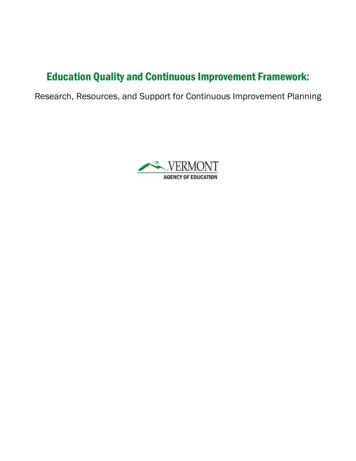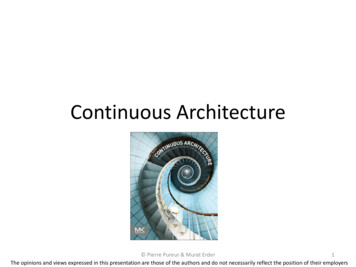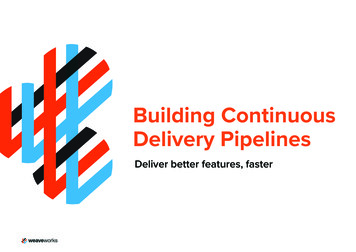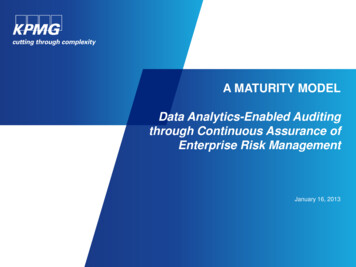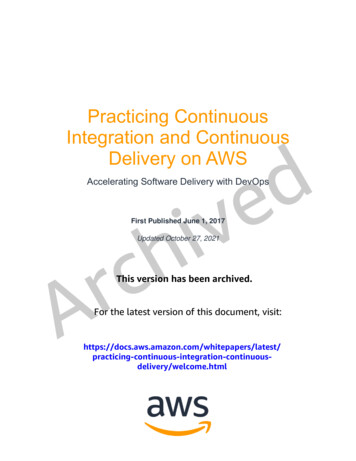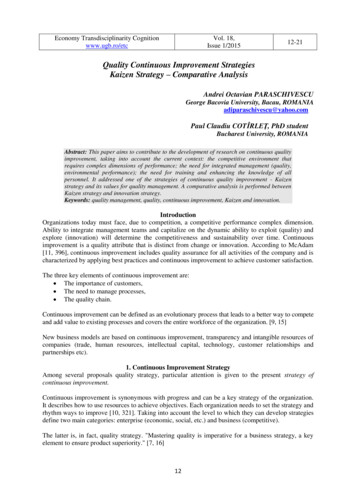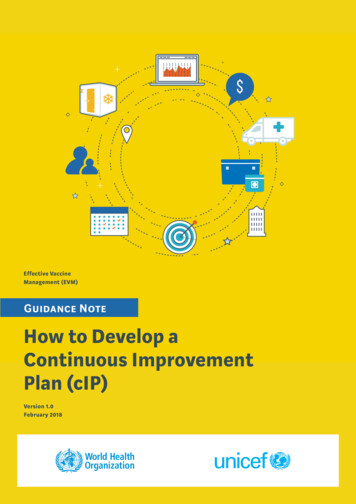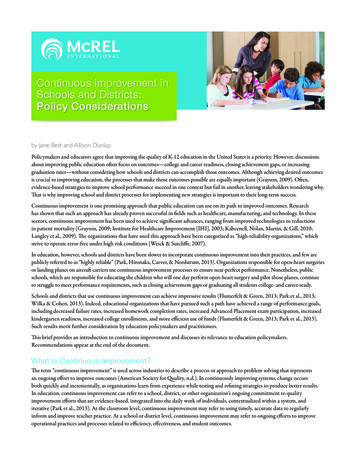
Transcription
Continuous Improvement inSchools and Districts:Policy Considerationsby Jane Best and Allison DunlapPolicymakers and educators agree that improving the quality of K-12 education in the United States is a priority. However, discussionsabout improving public education often focus on outcomes—college and career readiness, closing achievement gaps, or increasinggraduation rates—without considering how schools and districts can accomplish those outcomes. Although achieving desired outcomesis crucial to improving education, the processes that make those outcomes possible are equally important (Grayson, 2009). Often,evidence-based strategies to improve school performance succeed in one context but fail in another, leaving stakeholders wondering why.That is why improving school and district processes for implementing new strategies is important to their long-term success.Continuous improvement is one promising approach that public education can use on its path to improved outcomes. Researchhas shown that such an approach has already proven successful in fields such as healthcare, manufacturing, and technology. In thesesectors, continuous improvement has been used to achieve significant advances, ranging from improved technologies to reductionsin patient mortality (Grayson, 2009; Institute for Healthcare Improvement [IHI], 2003; Kabcenell, Nolan, Martin, & Gill, 2010;Langley et al., 2009). The organizations that have used this approach have been categorized as “high-reliability organizations,” whichstrive to operate error-free under high risk conditions (Weick & Sutcliffe, 2007).In education, however, schools and districts have been slower to incorporate continuous improvement into their practices, and few arepublicly referred to as “highly reliable” (Park, Hironaka, Carver, & Nordstrum, 2013). Organizations responsible for open-heart surgeriesor landing planes on aircraft carriers use continuous improvement processes to ensure near-perfect performance. Nonetheless, publicschools, which are responsible for educating the children who will one day perform open-heart surgery and pilot those planes, continueto struggle to meet performance requirements, such as closing achievement gaps or graduating all students college- and career-ready.Schools and districts that use continuous improvement can achieve impressive results (Flumerfelt & Green, 2013; Park et al., 2013;Wilka & Cohen, 2013). Indeed, educational organizations that have pursued such a path have achieved a range of performance goals,including decreased failure rates, increased homework completion rates, increased Advanced Placement exam participation, increasedkindergarten readiness, increased college enrollments, and more efficient use of funds (Flumerfelt & Green, 2013; Park et al., 2013).Such results merit further consideration by education policymakers and practitioners.This brief provides an introduction to continuous improvement and discusses its relevance to education policymakers.Recommendations appear at the end of the document.What Is Continuous Improvement?The term “continuous improvement” is used across industries to describe a process or approach to problem solving that representsan ongoing effort to improve outcomes (American Society for Quality, n.d.). In continuously improving systems, change occursboth quickly and incrementally, as organizations learn from experience while testing and refining strategies to produce better results.In education, continuous improvement can refer to a school, district, or other organization’s ongoing commitment to qualityimprovement efforts that are evidence-based, integrated into the daily work of individuals, contextualized within a system, anditerative (Park et al., 2013). At the classroom level, continuous improvement may refer to using timely, accurate data to regularlyinform and improve teacher practice. At a school or district level, continuous improvement may refer to ongoing efforts to improveoperational practices and processes related to efficiency, effectiveness, and student outcomes.
In all cases, continuous improvement involves a cyclical approach to problem solving:it allows relevant actors to reflect on their work, identify problem areas, pilot potentialsolutions to those problems, observe and evaluate interventions, and adapt interventionsbased on data collected (Flumerfelt & Green, 2013; Schmoker, 2006). There are multiplecontinuous improvement models built on this same basic cycle, including Plan, Do,Study, Act (PDSA); Sig Sigma (DMAIC); Lean; Results-Oriented-Cycle of Inquiry(ROCI); and Data Wise (Park et al., 2013).The four stages of PDSA, one longstanding model, usefully illustrate the continuousimprovement process:Plan: A continuous improvement team studies a problem that needs to be solved,collects baseline data on that problem, elaborates potential solutions to thatproblem, and develops an action plan.Do: The team implements its action plan, collects data on its intervention, andrecords developments.Study: The team gauges the success of the intervention by comparing baseline andnew data, analyzes results, and documents lessons learned.Act: The team determines what to do with its results. Depending on the successof its intervention, the team may choose to adopt, adapt, or abandon its testedsolution.(Gorenflo & Moran, 2010; Langley et al., 2009)With PDSA, as in other continuous improvement models, the use of an iterative processto rapidly move potential solutions into practice allows for ongoing quality improvement.After completing one cycle, the team begins a new cycle to test different solutions oraddress new problems.Summit Public Schools, aCalifornia charter school system, has formally adopted acontinuous improvement modelthat uses a “Build—Measure—Learn” cycle to rapidly prototype innovations. Guided bythe ultimate goal of college andcareer readiness for all students, educators propose andimplement potential innovationsduring the “Build” phase; usetechnology to gather studentand teacher feedback and dataduring the “Measure” phase;and reflect on progress andmake necessary changes duringthe “Learn” phase. Stakeholdersused this continuous improvement approach to successfullyshift schools to a nationallyrecognized blended learningmodel and continue to use thisapproach to test other innovations (Wilka & Cohen, 2013).Accounting for Continuous Improvement in Education PolicyAllowing for continuous improvement in schools and districts at the policy level requires consideration of numerous factors, includingthe following.Fewer, Specific, and Measurable GoalsSchools undertaking improvement projects frequently include more goals and action items in their improvement plans than can berealistically implemented (Goodwin, 2011). A continuous improvement approach involves addressing fewer problems more effectivelyby systematically testing potential solutions against specific, measurable goals (Bernhardt & Hebert, 2010; Cicchinelli, Dean, Galvin,Goodwin, & Parsley, 2006; “How to Improve,” 2014; Loeb & Plank, 2008). Because the continuous improvement process is iterativeand cyclical, schools and districts can work toward many goals over time. However, allowing schools and districts to focus on fewergoals at a time and later concentrate on others may help them achieve better results in the long term. The challenge with reducingthe number of goals that schools must reach, of course, is the high number of competing demands that schools currently manage.Nonetheless, ensuring that goals are clear, measurable, and actionable, while reducing their number as feasible, can support continuousimprovement efforts.–2–
FlexibilityEnacted in 2012, KRS 156.108and 160.107 allow Kentuckypublic school districts to applyto the Kentucky Board ofEducation to become Districtsof Innovation. Such districtsreceive flexibility from certainregulations, allowing themTimeto test innovative models.The continuous improvement process requires time—principals may need to research and Applicants must describeintroduce new instructional strategies, teachers may need to collaborate with and observehow they will use continuousother educators, and others may need to monitor progress and collect data (Bernhardt &improvement and reward riskHebert, 2010; Loeb & Plank, 2008). Allowing schools and districts the time necessarytaking to achieve 21st centuryto implement programs using a continuous improvement approach may increase thelearning goals. The flexibilitylikelihood of successful implementation.provided by this program hasallowed districts to test andData Use and Capacityimprove various innovationsParticipants in continuous improvement processes must collect and use data to evaluateranging from competencythe efficacy of interventions, make midterm corrections, and plan future actions. Such databased advancement tomust be timely, useful, reliable, and easily available (Loeb & Plank, 2008; Park et al., 2013).personalized learningFurther, educators and others involved must have the capacity to understand and use databased on a postsecondary(Park et al., 2013). Policy that allows for the creation of reliable data collection systemsmodel (“Innovation,”and training for relevant parties on how to use data can help schools and districts integrate2014; Pace, 2013).continuous improvement into regular operations (Loeb & Plank, 2008; Park et al., 2013).A continuous improvement approach to problem solving requires using rapid prototypingto test evidence- and context-based solutions. Participants must research evidence-basedsolutions; select one to implement; and adapt, adopt, or abandon that solution based onevaluation results. Such a process requires that schools and districts have the flexibility totake risks, test various possible solutions, and adjust programs midcourse (Bryk, 2009; Loeb& Plank, 2008). Providing this flexibility at the policy level allows schools and districts tocustomize evidence-based solutions to meet the needs of their individual contexts.EvaluationEvaluation plays a key role in continuous improvement because participants must regularly evaluate the efficacy of their interventions.Although current policy may include provisions for program evaluation, these evaluations often occur after a program has beencompleted (Loeb & Plank, 2008). Continuous improvement requires that evaluation occurs throughout a program and allows formidcourse corrections and changes. Designing policy to provide for evaluation from the beginning of a program, the collection ofbaseline data, and the flexibility to implement midcourse corrections based on evaluation results can help make interventions inschools and districts more effective (Loeb & Plank, 2008).LeadershipResearch on continuous improvement has shown that leaders play a crucial role insuccessful continuous improvement efforts (Langley, 2009; Marzano, Waters, & McNulty,2005; Park et al., 2013). Successful leaders use a formal improvement methodology, createa vision for improvement, enable others to pursue that vision, and monitor progress towardgoals (Park et al., 2013). Policy that provides for the training of school and district leadersin continuous improvement may help those leaders successfully incorporate continuousimprovement into their work.Knowledge SharingSuccessful continuous improvement efforts require that knowledge is shared acrossdifferent parts of organizations (IHI, 2003; Loeb & Plank, 2008; Park et al., 2013).Teachers in continuously improving systems share best practices with their peers andleaders, leaders share with their teachers and educators in other schools, and districts sharewith their schools and other districts. Knowledge-sharing policies, both those that focuswithin and across schools and districts, help support continuous improvement efforts.–3–The Nebraska Department ofEducation requires that schoolsengage in formal continuousschool improvement as acondition of accreditation.School improvement plansprovide staff time and trainingto reflect on priorities, setspecific goals (one of whichmust be tied to studentachievement), researcheffective practices, developand implement action plans(which must include alignedprofessional development),collect and analyze data,and evaluate the successof interventions (NebraskaDepartment of Education, 2012).
Capacity Building and Stakeholder InvestmentIntroducing continuous improvement to schools and districts may require a major cultural shift. New practices must be incorporatedinto all participants’ daily work, and organizational structures may need to change (Park et al., 2013). Further, stakeholder investmentin continuous improvement—fostered by the inclusion of student, educator, and community input—increases the likelihood thatinterventions will succeed (Wilka & Cohen, 2013). Policies that allow education leaders to manage change via staff training andpromote stakeholder investment via shared decision making can help ensure the successful integration of continuous improvementinto schools and districts (Park et al., 2013).Policy IssueQuestions to Consider1. What are the goals for schools and districts in my region? Are these goals appropriate, specific, andmeasurable?Allowing schoolsand districts touse continuousimprovementprocesses2. How much flexibility do schools and districts in my region have with regard to improving practices? Canschools and districts design their own interventions? Can they improve programs midcourse based onformative or interim data?3. How much time do educators and district officials have to reflect on and improve practices? Is the timeavailable sufficient for relevant actors to incorporate continuous improvement into their daily practices?4. Is continuous improvement possible in my region given current district and school cultures? Are theresystems in place to encourage the testing and refining of interventions?1. What data collection tools and systems can schools and districts in my region access? Do current datasystems provide information that is timely, relevant, reliable, and easily accessible?Using data andevaluation toimprove outcomes2. Do educators and district officials in my region understand how to use data to improve practice? Whattraining exists to help educators better use data?3. What mechanisms for the evaluation of programs in schools and districts currently exist? Do currentpractices allow for the collection of baseline data, ongoing evaluation from the beginning of a program,and continuous improvement based on midcourse evaluations?1. Are educators and district officials in my region currently using a continuous improvement approach?Do school and district leaders understand and use formal improvement methodologies? Do currentpractices allow for rapid prototyping and iterative development?Preparing educatorsto adopt continuousimprovement2. What quality improvement training can educators and district officials in my region access?3. Who can provide input into school and district improvement efforts? Do policies promote stakeholderinvestment in school and district improvement?4. What mechanisms exist for sharing knowledge within and among schools and districts in my region? Dothese mechanisms allow for the continuous improvement of school and district practices?–4–
RecommendationsContinuous improvement has proven useful and effective in various industries, and schools and districts incorporating continuousimprovement into their work have shown promising results. Policymakers interested in promoting continuous improvement in theirregions have much to consider. The following recommendations can assist policymakers as they begin this process: Investigate current improvement practices in schools and districts to determine whether formal improvement processes arein place, whether these processes allow for rapid prototyping, and how best to gauge the effectiveness of current methods. Review policies related to the number and type of goals that schools and districts are asked to reach, the rate at which theyare asked to achieve these goals, and the flexibility they are provided regarding said goals. Gather information on training and time devoted to continuous improvement in schools and districts. Compile and assess information on data collection, data systems, data use, and data sharing within and among schools anddistricts. Ensure that there are formative and interim measures to help strengthen continuous improvement efforts as they areimplemented. Examine policies related to the evaluation of school and district programs and determine whether they support continuousimprovement efforts. Assess current policy to determine what mechanisms are in place to promote stakeholder investment in school and districtimprovement.ReferencesAmerican Society for Quality. (n.d.). Continuous improvement. Retrieved from vement/overview/overview.htmlBernhardt, V., & Hebert, C. (2010). Response to intervention and continuous school improvement: Using data, vision, and leadership todesign, implement, and evaluate a schoolwide prevention system. New York: Routledge.Bryk, A. S. (2009). Support a science of improvement. Phi Delta Kappan, 90(8), 597–600.Cicchinelli, L., Dean, C., Galvin, M., Goodwin, B., & Parsley, D. (2006). Success in sight: A comprehensive approach to schoolimprovement. Denver, CO: Mid-continent Research for Education and Learning (McREL). Retrieved from s/product-listing/01 99/product-63Flumerfelt, S., & Green, G. (2013). Using Lean in the flipped classroom for at risk students. Educational Technology & Society, 16(1),356–366. Retrieved from http://www.ifets.info/journals/16 1/31.pdfGoodwin, B. (2011). Simply better: Doing what matters most to change the odds for student success. Alexandria, VA: ASCD.Gorenflo, G., & Moran, J. W. (2010). The ABCs of PDCA. Washington, DC: Public Health Foundation. Retrieved from urce 2f The ABCs ofPDCA.aspx&title The ABCs of PDCAGrayson, C. J. The Achilles heel of education and how to fix it. Houston, TX: APQC Education. Retrieved from ase/download-documents/doc n-and-how-to-fix-itHow to improve. (2014). Retrieved from fault.aspxInstitute for Healthcare Improvement. (2003). The Breakthrough Series: IHI’s collaborative model for achieving breakthroughimprovement. Boston, MA: Author. Retrieved from evingBreakthroughImprovement.aspx–5–
Kabcenell, A., Nolan, T. W., Martin, L. A., & Gill, Y. (2010). The Pursuing Perfection Initiative: Lessons on transforming health care.Cambridge, MA: Institute for Healthcare Improvement. Retrieved from ion. (2014). Retrieved from .aspxLangley, G. J., Moen, R., Nolan, K. M., Nolan, T. W., Normal, C. L., & Provost, L. P. (2009). The improvement guide: A practical approach toenhancing organizational performance (2nd ed.). San Francisco, CA: Jossey-Bass.Loeb, S., & Plank, D. (2008). Learning what works: Continuous improvement in California’s education system. (Policy brief ). Stanford,CA: PACE. Retrieved from 99s-education-systemMarzano, R. J., Waters, T., & McNulty, B. A. (2005). School leadership that works: From research to results. Alexandria, VA: ASCD.Nebraska Department of Education. (2012). Continuous improvement process toolkit. Retrieved from http://1.usa.gov/1ur0MnLPace, L., (2013). Innovation spotlight: Kentucky’s districts of innovation. Retrieved from k, S., Hironaka, S., Carver, P., & Nordstrum, L. (2013). Continuous improvement in education. Stanford, CA: Carnegie Foundation for theAdvancement of Teaching. Retrieved from les/carnegie-foundation continuousimprovement 2013.05.pdfSchmoker, M. (2006). Results now: How we can achieve unprecedented improvements in teaching and learning. Alexandria, VA: ASCD.Weick, K. E., & Sutcliffe, K. M. (2007). Managing the unexpected: Resilient performance in an age of uncertainty. San Francisco, CA: Jossey-Bass.Wilka, M., & Cohen, J. (2013). It’s not just about the model: Blended learning, innovation, and Year 2 at Summit Public Schools. San Francisco,CA: FSG. Retrieved from /Blended Learning Innovation.pdfMcREL International4601 DTC Blvd., Suite 500 Denver, CO 80237 800.858.6830 www.mcrel.org info@mcrel.org–6–
in continuous improvement may help those leaders successfully incorporate continuous improvement into their work. . of organizations (IHI, 2003; Loeb & Plank, 2008; Park et al., 2013). Teachers in continuously improving systems share best practices with their peers and leaders, leaders share with their teachers and educators in other schools .
